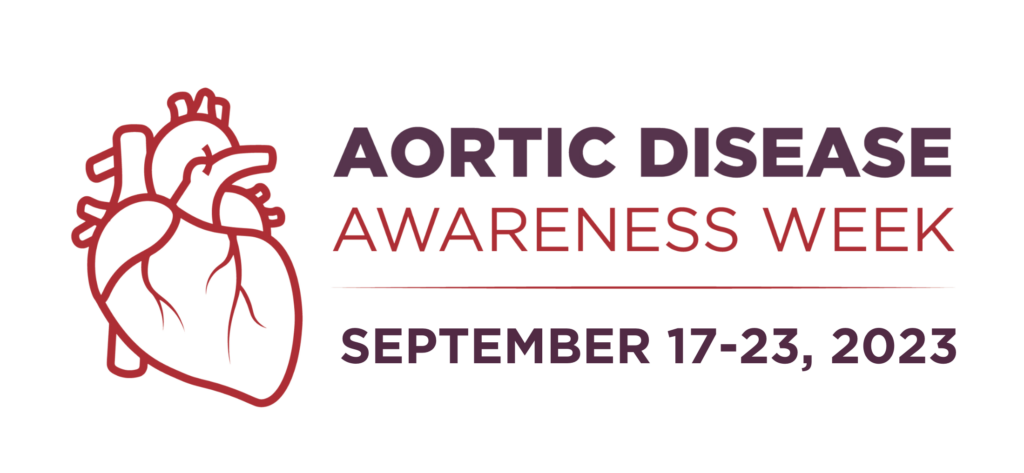

Note: If you are currently experiencing an emergency or crisis, you should contact your doctor, call 911, or go to the nearest emergency room.
Aortic Disease Awareness Week is a time when we especially focus on helping everyone understand the genetic risk factors for aortic dissection, the signs and symptoms of aortic emergency, how to prepare for an emergency, and how to best reduce risk.
In the population The Marfan Foundation serves — people with genetic aortic and vascular diseases due to conditions like Marfan, Loeys-Dietz, VEDS and related conditions – individuals have an estimated
250x increased risk of aortic dissection. That’s why this week matters.



Faces of Aortic Disease Awareness Week
What Everyone Should Know About Aortic Dissection
-
What is aortic dissection?
Aortic dissection is a tear or rupture between layers of the aortic wall that can be fatal and is always serious.
-
Who is at risk?
Several factors put people at risk for thoracic aortic aneurysm and dissection. The condition does not always cause symptoms; therefore, it is important to know if you are at risk so that the aorta can be repaired before it dissects.
-
Does it run in the family?
20% of people in the general population are at increased risk of aortic dissection, due to genes.
-
Symptoms of aortic dissection
Everyone should know the signs and symptoms of aortic dissection, and seek emergency medical help for themselves or loved ones immediately if they occur.
Symptoms of aortic dissection usually appear suddenly and may include:
• Severe, sudden, constant chest pain and/or upper back pain, sometimes described as “ripping” or “tearing.”
• Pain that feels like it is moving from one place to another
• Unusually pale skin
• Faint pulse
• Numbness or tingling
• Paralysis
• In some instances, there may be no pain but a sense that there is something terribly “wrong.” -
Symptoms of aortic aneurysm
Symptoms of aortic aneurysm may be related to the location, size and growth rate of the aneurysm and can include:
• Pain in the chest, neck, and/or back
• Swelling of the head, neck, and arms
• Coughing, wheezing, or shortness of breath
• Coughing up blood -
Stay ahead of aortic risk
People who are aware that they are at increased risk can help mitigate their risk for experiencing aortic dissection by working closely with their healthcare providers which may include a medical geneticist, cardiologist, and cardiovascular surgeon.
Learn how to find your healthcare team here.

Joaquin’s Story
“My whole world changed in an instant…”
On July 31, 2020, my whole world changed in an instant. I came back home from an early dinner. Suddenly my whole left arm went numb. I started sweating even though my house was cool. I could not feel my left arm. I called my sister and brother-in-law who work in the medical field as pharmacists, and they told me that I should go to the ER to be on the safe side.
How Can I Help?
-
Spread the Word
• Visit our official social media accounts, like and share our message.
• Download our ADAW art and post to your social media between 9/17 and 9/23/2023.
-
Learn More
Use the resources on this page to better understand aortic emergencies, prevention, and risk. Know the signs and symptoms.
-
Donate Today
Your contribution saves lives! Donate TODAY to advance education, prevention, and treatment of genetic aortic conditions.
Find us on Social
Prepare for Emergencies
If you are at increased risk, know how to advocate for yourself during an emergency. We have tools to help!

In this two-minute video, Dr. Kim Eagle talks about the three things he wishes every emergency department caregiver knew about aortic emergencies.
Please share with the healthcare providers in your life!
Life-Saving Resources
Taking Care of Your Aorta
Imaging Surveillance and Management in Adults with Aortopathy
Advances in Treatment of Aortic Dissection
Diagnosis and Treatment of Aortic Dissection in the ER (Part 1)
Diagnosis and Treatment of Aortic Dissection in the ER (Part 2)
FOR HEALTHCARE PROFESSIONALS
Note: If you are currently experiencing an emergency or crisis, you should contact your doctor, call 911, or go to the nearest emergency room.
